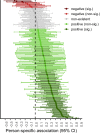Explaining variation in adolescents' social media-related distraction: The role of social connectivity and disconnectivity factors
- PMID: 36468162
- PMCID: PMC9684974
- DOI: 10.1007/s12144-022-03844-y
Explaining variation in adolescents' social media-related distraction: The role of social connectivity and disconnectivity factors
Abstract
Social media are often believed to distract adolescents' attention. While existing research has shown that some adolescents experience more social media-related distraction than others, the explanations for these differences remain largely unknown. Based on Self-Determination Theory, this preregistered study investigated two social connectivity factors (fear of missing out [FoMO] and friendship accessibility expectations) and two disconnectivity factors (self-control strategies and parental restrictions) that may explain heterogeneity in social media-related distraction. We used data collected through a measurement burst design, consisting of a three-week experience sampling method study among 300 adolescents (21,970 assessments) and online surveys. Using N = 1 analyses, we found that most adolescents (77%) experienced social media-related distraction. Contrary to expectations, none of the connectivity or disconnectivity factors explained differences in social media-related distraction. The findings indicate that social media are a powerful distractor many adolescents seem to struggle with.
Keywords: Attention; ESM; Instagram; Media effects; N = 1 research.
© The Author(s) 2022.
Conflict of interest statement
Competing interests The authors have no competing interests to declare that are relevant to the content of this article.
Figures



Similar articles
-
Social media use and friendship closeness in adolescents' daily lives: An experience sampling study.Dev Psychol. 2021 Feb;57(2):309-323. doi: 10.1037/dev0001148. Dev Psychol. 2021. PMID: 33539132
-
Fear of Missing Out as a Predictor of Problematic Social Media Use and Phubbing Behavior among Flemish Adolescents.Int J Environ Res Public Health. 2018 Oct 22;15(10):2319. doi: 10.3390/ijerph15102319. Int J Environ Res Public Health. 2018. PMID: 30360407 Free PMC article.
-
Why Are We Distracted by Social Media? Distraction Situations and Strategies, Reasons for Distraction, and Individual Differences.Front Psychol. 2021 Dec 2;12:711416. doi: 10.3389/fpsyg.2021.711416. eCollection 2021. Front Psychol. 2021. PMID: 34925123 Free PMC article.
-
Digital Media Use and Adolescents' Mental Health During the Covid-19 Pandemic: A Systematic Review and Meta-Analysis.Front Public Health. 2022 Feb 1;9:793868. doi: 10.3389/fpubh.2021.793868. eCollection 2021. Front Public Health. 2022. PMID: 35186872 Free PMC article.
-
Social media, parenting, and well-being.Curr Opin Psychol. 2022 Oct;47:101350. doi: 10.1016/j.copsyc.2022.101350. Epub 2022 Apr 11. Curr Opin Psychol. 2022. PMID: 35561563 Review.
Cited by
-
Readdressing the Ongoing Challenge of Missing Data in Youth Ecological Momentary Assessment Studies: Meta-Analysis Update.J Med Internet Res. 2025 Apr 30;27:e65710. doi: 10.2196/65710. J Med Internet Res. 2025. PMID: 40305088 Free PMC article.
-
Emotional and Behavioural Factors Predisposing to Internet Addiction: The Smartphone Distraction among Italian High School Students.Int J Environ Res Public Health. 2024 Mar 22;21(4):386. doi: 10.3390/ijerph21040386. Int J Environ Res Public Health. 2024. PMID: 38673299 Free PMC article.
-
Perceived value of video games, but not hours played, predicts mental well-being in casual adult Nintendo players.R Soc Open Sci. 2025 Mar 12;12(3):241174. doi: 10.1098/rsos.241174. eCollection 2025 Mar. R Soc Open Sci. 2025. PMID: 40078920 Free PMC article.
-
Ten Myths About the Effect of Social Media Use on Well-Being.J Med Internet Res. 2024 Nov 25;26:e59585. doi: 10.2196/59585. J Med Internet Res. 2024. PMID: 39586087 Free PMC article. Review.
References
-
- Aalbers, G., vanden Abeele, M. M., Hendrickson, A. T., de Marez, L., & Keijsers, L. (2021). Caught in the moment: Are there person-specific associations between momentary procrastination and passively measured smartphone use? Mobile Media & Communication, 10(1), 115–135. 10.1177/2050157921993896
-
- Adachi P, Willoughby T. Interpreting effect sizes when controlling for stability effects in longitudinal autoregressive models: Implications for psychological science. European Journal of Developmental Psychology. 2015;12(1):116–128. doi: 10.1080/17405629.2014.963549. - DOI
-
- Al-Furaih SA, Al-Awidi HM. Fear of missing out (FoMO) among undergraduate students in relation to attention distraction and learning disengagement in lectures. Education and Information Technologies. 2021;26(2):2355–2373. doi: 10.1007/s10639-020-10361-7. - DOI
-
- Allen, K. A., Ryan, T., Gray, D. L., McInerney, D. M., & Waters, L. (2014). Social media use and social connectedness in adolescents: The positives and the potential pitfalls. Australian Educational Developmental Psychologist,31(1), 18–31. 10.1017/edp.2014.2
LinkOut - more resources
Full Text Sources
